Table of contents
- Honda Crossrunner in the test Good for work and play
- Met all expectations of crossover motorcycles
- The engine through to the exhaust system is completely identical to the VFR
- Excellent running smoothness and sparkling sound
- Shift assistant for a surcharge of 290 euros
- Rear-heavy Honda Crossrunner offers plenty of traction on the rear wheel
- Pillion seat extremely comfortable
- Technical data Honda Crossrunner
- Set up
- Comparison of VFR 800 F and Crossrunner
- The steering head of the Honda VFR 800 F is steeper
- competitor
- MOTORCYCLE measurements
- MOTORCYCLE scoring
- Conclusion
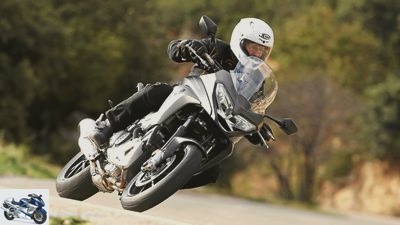
markus-jahn.com
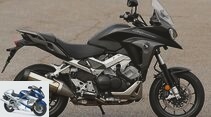
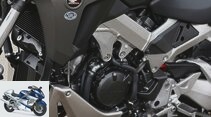
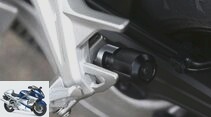

28 pictures
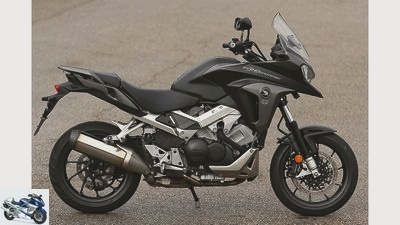
markus-jahn.com
1/28
Honda Crossrunner.
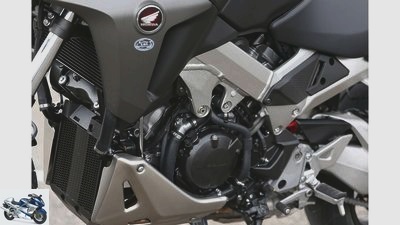
markus-jahn.com
2/28
The basic construction of the Crossrunner comes from the time when Honda mounted the swing arm in the engine.
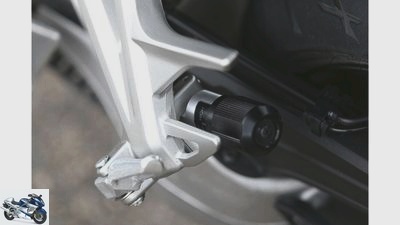
markus-jahn.com
3/28
A colleague said the spring preload knob was difficult to reach. This is a luxury problem.
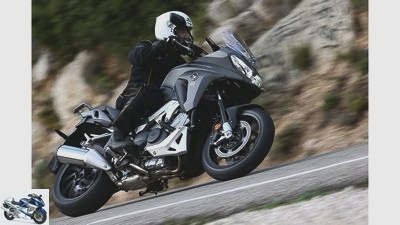
markus-jahn.com
4/28
Honda Crossrunner.
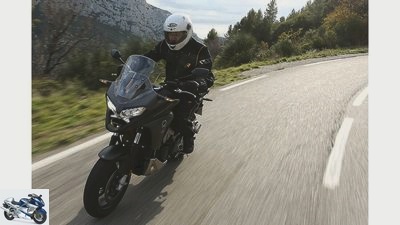
markus-jahn.com
5/28
Honda Crossrunner.
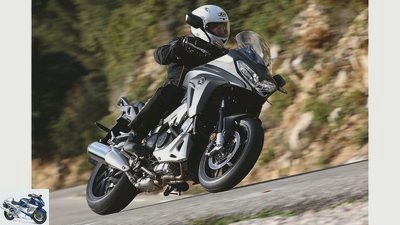
markus-jahn.com
6/28
Honda Crossrunner.
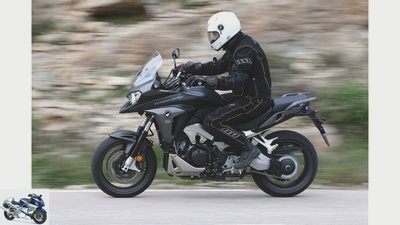
markus-jahn.com
7/28
Honda Crossrunner.
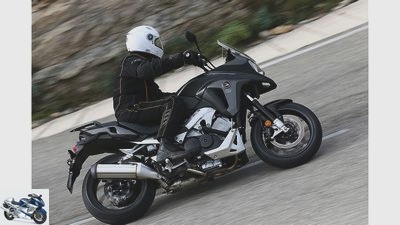
markus-jahn.com
8/28
Honda Crossrunner.
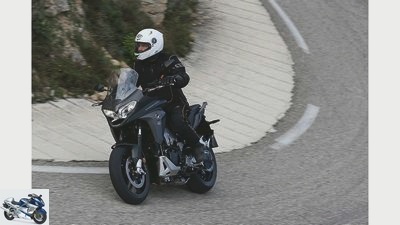
markus-jahn.com
9/28
Honda Crossrunner.

markus-jahn.com
10/28
Honda Crossrunner.
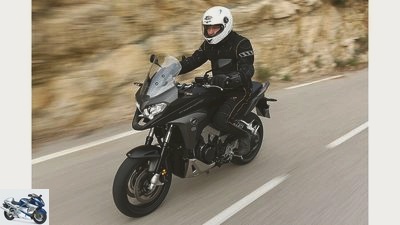
markus-jahn.com
11/28
Honda Crossrunner.
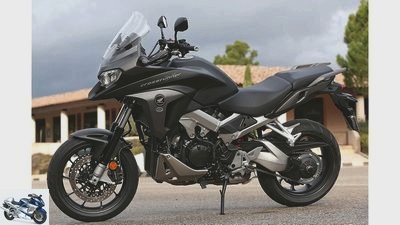
markus-jahn.com
12/28
Honda Crossrunner.
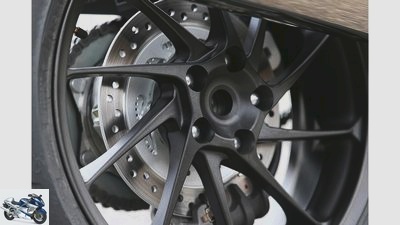
markus-jahn.com
13/28
A great visual benefit: the new ten-spoke wheels, adopted from the 2014 VFR.
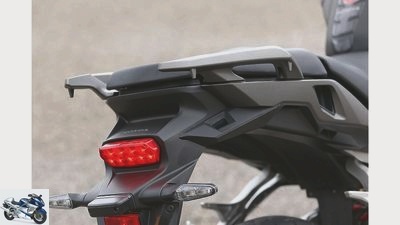
markus-jahn.com
14/28
Honda Crossrunner.
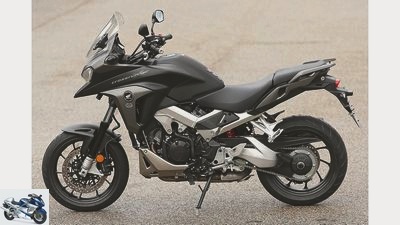
markus-jahn.com
15/28
Honda Crossrunner.

markus-jahn.com
16/28
Honda Crossrunner.
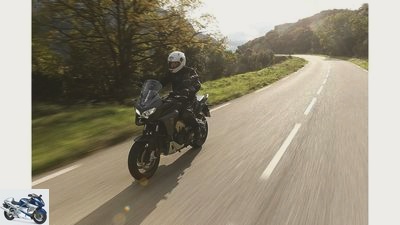
markus-jahn.com
17/28
Honda Crossrunner.
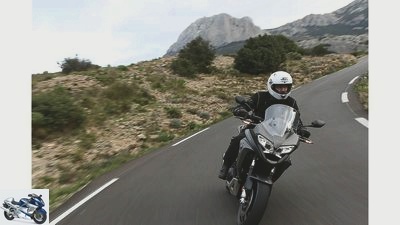
markus-jahn.com
18/28
Honda Crossrunner.
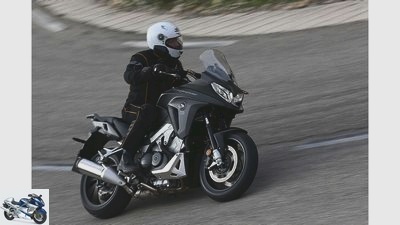
markus-jahn.com
19/28
Honda Crossrunner.
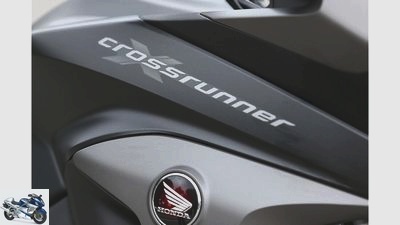
markus-jahn.com
20/28
Honda Crossrunner.
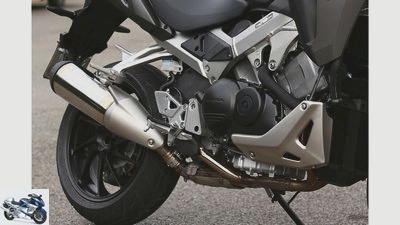
markus-jahn.com
21/28
The stainless steel exhaust system would be even nicer if the temper colors were brushed from the welds.
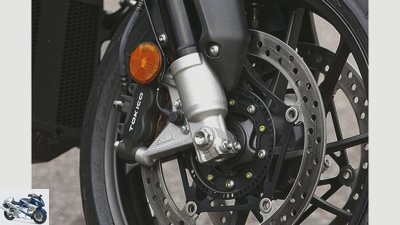
markus-jahn.com
22/28
Honda Crossrunner.
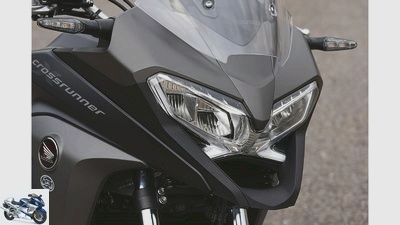
markus-jahn.com
23/28
Honda Crossrunner.
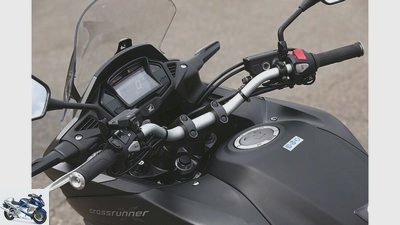
markus-jahn.com
24/28
The crossrunner can be guided in a relaxed manner on the wide aluminum handlebar. The operation of all functions is easy to learn, their status is clearly displayed. However…
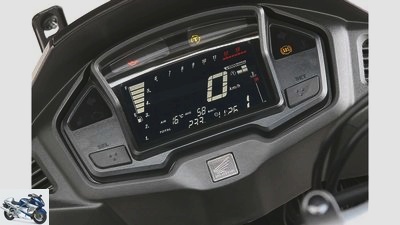
markus-jahn.com
25/28
The LCD display reflects.
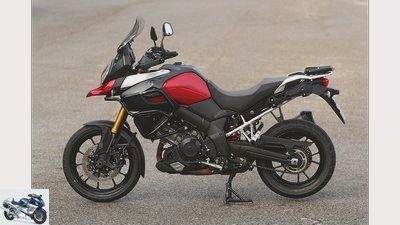
markus-jahn.com
26/28
The competition: Suzuki V-Strom 1000.
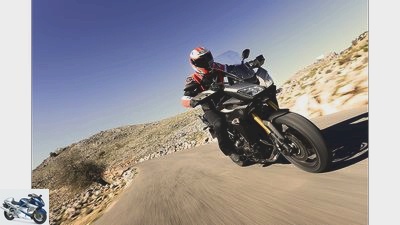
Yamaha
27/28
The competition: Yamaha MT-09 Tracer.
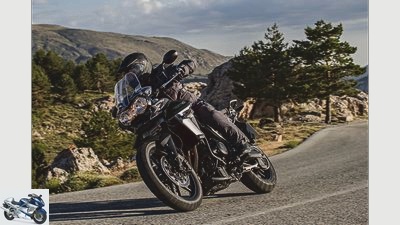
triumph
28/28
The competition: Triumph Tiger 800 XR.
motorcycles
Honda Crossrunner in the test
Honda Crossrunner in the test
Good for work and play
You can use it and like it, it is serious through and through and loves playful curve slalom, is reserved but not unattractive – the new Honda Crossrunner combines all of this. In terms of mass distribution, it is not completely balanced, but offers a nice work-play balance.
Ralf Schneider
01/08/2015
It was warm in southern France just before Christmas. Unfortunately also quite damp, as is often the case when the temperature reaches 16 degrees at this time. Cloud front after cloud front rolled across the Mediterranean, driven by the warm south wind; some people happily rained down on the Provençal hills. Then the roads on the north side hardly get dry, and more and more ocher-colored and red earth diffuses onto the roadways from all entrances to fields or forest parking lots. The constant alternation of sun and clouds, wet, semi-wet and dry, does not offer ideal conditions for motorcycling, but the Honda does Crossrunner is an ideal motorcycle for such conditions.
Buy complete article
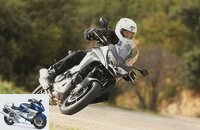
Honda Crossrunner in the test
Good for work and play
8 pages) as PDF
€ 2.00
Buy now
Weighing an impressive 245 kilograms, the Honda Crossrunner lies well on the road, gives the driver the best possible overview in a comfortable seating position with a narrow knee and gives him safety thanks to its wonderfully neutral steering properties.
Met all expectations of crossover motorcycles
The redesign of its fairing has not only made the Honda Crossrunner visually more pleasing, but also noticeably improved the wind protection thanks to the twelve centimeters higher front section. Drivers between 1.70 and 1.85 meters tall are effectively shielded by the fairing up to about shoulder height; Although the helmet is in the air flow, it is not buffeted by turbulence, which is perceived as very pleasant and also improves safety and steering precision.
Compared to its predecessor, presented in 2011, Honda has shortened the suspension travel of the Honda Crossrunner by 20 millimeters at the front and lengthened it by a trifle of three millimeters at the rear. This is most likely related to the newly designed, lighter and stiffer swingarm that was also given the 2014 VFR. The changes have reinforced the impression that the spring mechanism is very comfortably tuned. The Crossrunner was able to iron almost wrinkle-free even two and a half kilometers of rumble slope to a remote hiking parking lot. Although its chassis, with the exception of the longer-stroke spring elements, was adopted from the Honda VFR 800 F, it still offers all the comfort that one can expect from so-called crossover motorcycles, the combination of roadworthiness and a certain off-road suitability. Sporty country road drivers will probably find them a little too softly sprung and too gently cushioned.
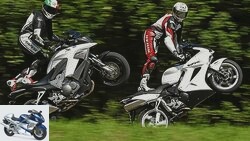
Tourer
Test: Honda Crossrunner against VFR 800
Honda tourer in comparison test
read more
The engine through to the exhaust system is completely identical to the VFR
The Honda engineers have resolved a curious problem that arises from the combination of the road chassis and the towering travel enduro front: Because of the low-set steering head of the Honda Crossrunner, the screw heads for pretensioning the fork springs are deep in the fairing, closely surrounded of plastic. No chance of using a twelve-wrench to adjust the preload. With a short metal spanner from the vehicle tool kit it works.
If there are differences between the VFR and the Honda Crossrunner in terms of suspension travel, tuning and geometry, the engines and the exhaust system are completely identical. It is therefore all the more astonishing that the current test machine has a small but noticeable performance and torque advantage from around 5000 rpm compared to the VFR tested in the summer. Anyone who treats her with extreme benevolence could almost think that the Vtec would make the transition from two to four valve operation a tad smoother. Although the brief flow chaos that occurs when the second valve group is opened will always be reflected in the performance curve. In any case, its predecessor surpasses the current Crossrunner over the entire speed range.
Excellent running smoothness and sparkling sound
With measured 108 HP and just over 80 Nm, the Honda Crossrunner could almost be described as powerful. This impression is of course supported by the roads, which are not always easy to grip, and which raise modesty when it comes to performance. Anyone who can really pull hard in summer with optimal grip will still find the V4 a bit weak and demand a 1000 without Vtec. Honda has not yet brought such an engine because the 782 is not suitable as a basis for it. The compact housing with the cast cylinder blocks prevents the installation of a crankshaft with a longer stroke, and even more bore would probably not help the already very short-stroke engine to achieve better pulling power. All that remains is a completely new design, the development costs of which Honda apparently shy away from. Presumably, the Japanese engineers would hardly build another V4, but an in-line engine with two, three or four cylinders that could be produced more cheaply.
So let’s continue to enjoy the excellent running smoothness and the sparkling sound of the original and now rare engine concept. Especially since the Crossrunner has a decent load change behavior. Accentuated, but not hard, the V4 accelerates, and even in the apex of the tightest turns you can get the Honda Crossrunner back under tension more quickly than, for example, a Suzuki V-Strom 1000, which was used as a reference machine. Even such little things help to keep up with large-volume motorcycles despite the inferior torque.
Shift assistant for a surcharge of 290 euros
The gearbox of the Honda Crossrunner was extremely easy to shift. The gear changes are easy, quick and safe; noises only occur when downshifting at a minimum speed. But they don’t sound uncomfortable. For a surcharge of 290 euros, the Crossrunner and the VFR can be equipped with a gearshift assistant; it harmonized well with the transmission. The other range of special accessories includes suitcases, two different top cases, a crash cage, with fog lights on request, a main stand and more.
The new Honda Crossrunner has more electronics in the form of a two-stage traction control (HSTC for Honda Selectable Torque Control) and even five-stage heated grips. Both are standard, their function is shown on the well-stocked LCD display. The control button for the traction control is not integrated into the steering controls as homogeneously as in BMW or Ducati, for example, but was literally placed on the left end of the handlebar. Nevertheless, it is easy to reach with the thumb and it is very easy to use. When standing, the three-stage offer “Stage one”, “Stage two” and “Off” is played through by pressing it three times. It also has a certain charm when the driver doesn’t have to click through multi-level menus.
Rear-heavy Honda Crossrunner offers plenty of traction on the rear wheel
The MOTORRAD testers were able to measure the driving performance on the famous Mistral straight of the Circuit Paul Ricard, but the track width was lacking for a test in the circular path, which would have allowed a systematic examination of the traction control. So the realization remains that the HSTC usually allows more than the driver dares to accelerate in an inclined position – even in the early stage two. The rear-heavy Honda Crossrunner obviously offers plenty of traction on the rear wheel. When starting up sharply or accelerating over hilltops, i.e. when the front wheel becomes light, the traction control intervenes very early. It then regulates the power down until the front wheel rotates again at the same speed as the rear wheel.
The Honda engineers have also tuned the ABS in an emphatically conservative manner. The deceleration remains limited to 9.2 m / s2. This can be seen from the fact that this value is even reached on a partially wet track. Thanks to the long wheelbase and again the heavy rear, the Honda Crossrunner stays neatly on track with full deceleration. You can only provoke a brief stir around the steering axis if you tear through the brake lever very abruptly with all your might. However, this statement is not intended to indicate a defect, but rather to describe which acts of violence are necessary to elicit any expression of resentment from her at all. As top tester Georg Jelicic correctly writes in the commentary on the measured values, relatively high manual strength is required for full deceleration. It should be added, however, that the brake reacts spontaneously when gently applied for slight adaptive braking, i.e. by no means acts bluntly.
Pillion seat extremely comfortable
The light of the LED headlights, which the Honda Crossrunner, like so many other things, has taken over from the VFR, is anything but dull. The light / dark border is drawn so sharply that it immediately becomes dark in the far area in front of the bright light bar and a relatively dark zone also arises in the middle distance in front of the front wheel. This is fine when driving straight ahead, but when things get twisty or you have to brake sharply, you want a more evenly illuminated field between the near and far range.
Finally, a word about the pillion seat. It is extremely comfortable and the handles on the rear are easy to reach. In this respect, too, the Honda Crossrunner proves to be a motorcycle of high practical value and pleasant manners, good for work and play.
Technical data Honda Crossrunner

markus-jahn.com
The basic construction of the Crossrunner comes from the time when Honda mounted the swing arm in the engine.
Honda Crossrunner
Engine: Water-cooled four-cylinder four-stroke 90 degree V engine, two overhead, chain-driven camshafts, four valves per cylinder, bucket tappets, wet sump lubrication, injection, 4 x Ø 36 mm, regulated catalytic converter with secondary air system, 427 W alternator, 12 V battery / 11 Ah, hydraulically operated multi-disc oil bath clutch, six-speed gearbox, O-ring chain, secondary ratio 2.688, 43:16.
Bore x stroke: 72.0 x 48.0 mm
Displacement: 782 cm³
Compression ratio: 11.8: 1
Rated output: 78.0 kW (106 hp) at 10,250 rpm
Max. Torque: 75 Nm at 8500 rpm
Landing gear: Bridge frame made of aluminum, telescopic fork, Ø 43 mm, adjustable spring base and rebound damping, single-sided swing arm made of aluminum, central spring strut with lever system, adjustable spring base and train-
Step damping, double disc brake at the front, Ø 310 mm, four-piston fixed calipers, disc brake at the rear, Ø 256 mm, double-piston floating caliper, traction control, ABS.
Cast aluminum wheels: 3.50 x 17; 5.50 x 17
Tires: 120/70 R 17; 180/55 R 17
Tires tested: Pirelli Scorpion Trail
DIMENSIONS + WEIGHT: Wheelbase 1475 mm, steering head angle 63.5 degrees, caster 103 mm, spring travel f / r 145/148 mm, permissible total weight 432 kg, tank capacity 20.8 liters.
Service data
Service intervals: 12,000 km
Oil and filter change: every 12,000 km, 3.1 liters
Engine oil: 10W30
Telescopic fork oil: 10W
Spark plugs: NGK IMR9D-9H, Denso VNH27ZB
Idle speed: 1200 ± 100 / min
Tire pressure: solo (with pillion passenger)
front / rear: 2.5 / 2.9 (2.5 / 2.9) bar
Warranty: two years
Colors: red, black, white
Price: 11,695 euros
Additional costs: 295 euros
Set up
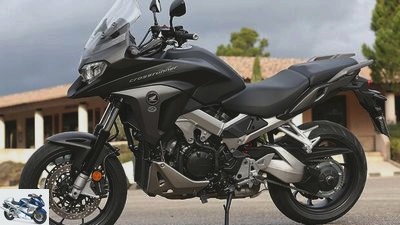
markus-jahn.com
The Honda Crossrunner weighs a whopping 245 kilograms.
Country road
fork
Rebound stage: 1.5 turns *
Pretension: 3 rings visible
Shock absorber
Rebound: 1.0 turns *
Pretension: 3 lines visible
* Counted from the fully closed position
Comparison of VFR 800 F and Crossrunner
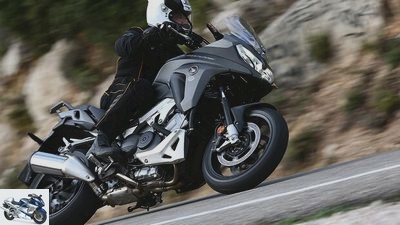
markus-jahn.com
The engines up to the exhaust system of the Honda VFR 800 F and the Honda Crossrunner are completely identical.
One kit, two models
Engine developments are particularly expensive. This is why manufacturers try to create as many different models as possible on the basis of a single design. As in the case of the Honda Crossrunner and the Honda VFR 800 F.
At the turn of the millennium, Honda gained a major technological lead over the competition. Years before it became mandatory, the engines met the Euro 3 standard. This allows product planners to develop new models based on “old” engines. A prime example of this are the VFR 800 F and the Honda Crossrunner. A consistent common parts strategy determines the technology and appearance of the two sisters. Frame, swing arm, engine and all ancillary units, intake and exhaust systems, drive train, headlights – all the same. Yes, even where the two motorcycles differ, for example in the fork, the lower tubes can be used for both despite different spring travel.
Even so, the two are completely different motorcycles. The MOTORRAD testers did not compare them directly with one another, but in the summer of 2014 they had to do intensively with the VFR, which now always rode along in the tests with the Honda Crossrunner. While the differences in the engines described in the top test are probably due to manufacturing tolerances and in one case or another a VFR will catch a stronger specimen, there are fundamental differences in the design and coordination of the chassis.
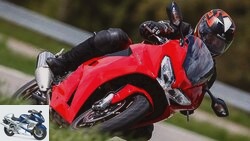
Tourer
Honda VFR 800 F in the top test
Running miracle reissued
read more

Tourer
Honda VFR 800 F in the driving report
Equipped for the future
read more
The steering head of the Honda VFR 800 F is steeper
The caster and wheelbase of the VFR are shorter, the steering head is steeper and the driver’s seating position is more front-wheel-oriented thanks to the lower handlebar halves. In addition, the VFR packs significantly more weight on the front wheel with exactly the same total weight, although it still remains slightly rear-heavy. So much for the theory. What this means in terms of driving dynamics became particularly clear when the track master of the Circuit Paul Ricard served a small driver dessert after completing the test drives. He offered the testers to do a few short laps of one and a half kilometers in the back of the racetrack. This driving program is not at all the business of the Honda Crossrunners. After just two laps, the tires began to overheat and smear.
This was externally visible on the dark gray rubber lines in the acceleration zones and on the occasional glowing traction control light. Above all, however, it was felt in the crumple, indifferent driving behavior and the discomfort of diving into deeper lean angles. You don’t need a head-to-head comparison to predict that the VFR would have been circling its sister on the circuit. Comparatively well damped, with precise feedback from the front wheel, it would have inspired the driver to take a brisk pace. On the other hand, he probably prefers to catapult him into the terrain when driving over the aforementioned bumpy stretch. Mind you, the VFR still offers excellent comfort in the group of touring athletes, the Honda Crossrunner drives like a litter.
competitor
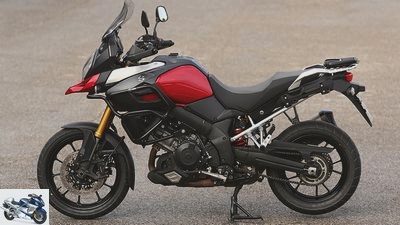
markus-jahn.com
One of the three main competitors of the Honda Crossrunner is the Suzuki V-Strom 1000.
Suzuki V-Strom 1000
Two-cylinder V-engine, 100 PS, weight 229 kg, 0-100 km / h 4.0 seconds, Vmax 2015 km / h, consumption 4.9 liters, price 12,540 euros
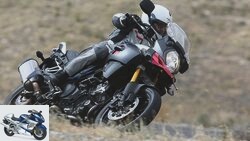
Enduro
Suzuki V-Strom 1000 in the driving report
Low weight, powerful torque, easy drivability
read more
Triumph Tiger 800 XR
Three-cylinder in-line engine, 95 hp, top speed 210 km / h, price 10,340 euros
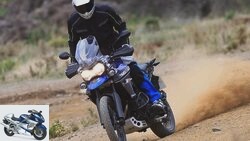
Enduro
Driving report Triumph Tiger 800 XR, XC, XRx and XCX
X for offense …
read more
All articles about the Triumph Tiger 800 XR
Yamaha MT-09 Tracer ABS
Three-cylinder in-line engine, 115 hp, top speed 210 km / h, 9765 euros
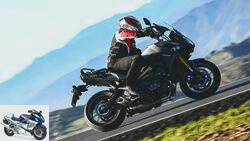
Tourer
Yamaha MT-09 Tracer in the driving report
Extremely suitable for everyday use, lavishly equipped
read more
All reviews and articles about the Yamaha MT-09 Tracer
MOTORCYCLE measurements
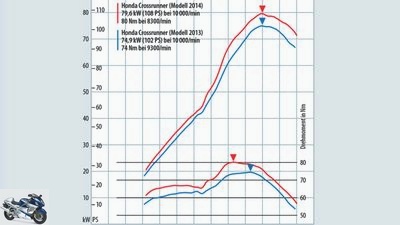
Honda
Performance measurements.
Performance
Top speed *: 209 km / h
acceleration
0-100 km / h: 3.7 sec
0–140 km / h: 6.3 seconds
0-200 km / h: 15.8 seconds
Draft
60–100 km / h: 5.4 seconds
100–140 km / h: 6.4 seconds
140–180 km / h: 8.5 seconds
Speedometer deviation
effective (display 50/100): 48/98 km / h
Tachometer deviation
Display red area: 12,000 / min
effective: 12,200 rpm
consumption
Country road: 4.8 l / 100 km
at 130 km / h: 6.3 l / 100 km
theoretical range of road: 433 km
Fuel type: Super
DIMENSIONS + WEIGHTS
L / W / H: 2220/940/1300 mm
Seat height: 810–830 mm
Handlebar height: 1130 mm
Turning circle: 5300 mm
Weight with a full tank: 245 kg
Payload: 187 kg
Wheel load distribution v./h .: 48.3 / 51.7%
MOTORCYCLE scoring

markus-jahn.com
A great visual benefit: the new ten-spoke wheels, adopted from the 2014 VFR.
engine
| maximum number of points | Honda Crossrunner | |
| Draft | 40 | 18th |
| acceleration | 40 | 24 |
| Top speed | 30th | 14th |
| Engine characteristics | 30th | 17th |
| Responsiveness | 20th | 14th |
| Load change | 20th | 13th |
| Smoothness | 20th | 14th |
| coupling | 10 | 8th |
| circuit | 20th | 14th |
| Gear ratio | 10 | 7th |
| Start | 10 | 7th |
| total | 250 | 150 |
The small performance advantage of the Honda Crossrunner you are unfortunately of no use in the imaginary acceleration duel with the VFR, as the poorer aerodynamics slow down at higher speeds. Responsiveness, load changes, smoothness and the quality of the circuit, on the other hand, are at the highest level. Due to the lower top speed with the same ratios, the sixth gear on the Crossrunner acts as a long-ratio overdrive. It is not only suitable for the motorway, but also for speedy cruising across the country.
landing gear
| maximum number of points | Honda Crossrunner | |
| Handiness | 40 | 29 |
| Stability in curves | 40 | 26th |
| Steering behavior | 40 | 30th |
| feedback | 10 | 6th |
| Inclined position | 20th | 16 |
| Straight-line stability | 20th | 17th |
| Suspension tuning in front | 20th | 13th |
| Chassis tuning at the rear | 20th | 13th |
| Adjustment options undercarriage | 10 | 6th |
| Suspension comfort | 10 | 8th |
| Driving behavior with a passenger | 20th | 14th |
| total | 250 | 178 |
Eight out of ten points for suspension comfort – this individual rating says a lot about the character of the Honda Crossrunner. Because it runs steadily in a straight line, Honda was also able to do without the somewhat strange speed limit of 200 km / h on its predecessor. Since when you think of pillion suitability you usually only think of the passenger, it should be emphasized here that the driver on the Crossrunner likes to take a passenger with him because the additional weight hardly affects the driving characteristics.
everyday
| maximum number of points | Honda Crossrunner | |
| Ergonomics driver | 40 | 30th |
| Ergonomics pillion | 20th | 14th |
| Windbreak | 20th | 12th |
| view | 20th | 12th |
| light | 20th | 15th |
| Furnishing | 30th | 23 |
| Handling / maintenance | 30th | 15th |
| Luggage storage | 10 | 1 |
| Payload | 10 | 5 |
| Range | 30th | 28 |
| processing | 20th | 14th |
| total | 250 | 169 |
Wind protection is a sensitive issue when scoring points. Some, for example the author, are allergic to turbulence and would rather not have a window than sit in a hurricane. The others want to have every square inch of their body covered and put up with vertebrae. Unfortunately, the others predominate at MOTORRAD, which is why the Honda Crossrunner only gets twelve points. In return, it really creams off the range. Honda pays dearly for better luggage storage; however, the corresponding accessories are well integrated.
security
| maximum number of points | Honda Crossrunner | |
| Braking effect | 40 | 31 |
| Brake metering | 30th | 23 |
| Braking with pillion passenger / fading | 20th | 14th |
| Righting moment when braking | 10 | 8th |
| ABS function | 20th | 14th |
| Handlebar slapping | 20th | 17th |
| Ground clearance | 10 | 8th |
| total | 150 | 115 |
When you purposely heat over an asphalt field, to provoke a slap in the handlebars, but practically nothing moves, then that’s worth 17 out of 20 points. In addition to the other virtues of the Honda Crossrunners, which have already been recognized elsewhere, this criterion says a lot about their personality.
costs
| maximum number of points | Honda Crossrunner | |
| guarantee | 30th | 15th |
| Consumption (country road) | 30th | 20th |
| Inspection costs | 20th | 18th |
| Maintenance costs | 20th | 10 |
| total | 100 | 63 |
It is certainly not the sheer joy of working on a compact V4, however, a major inspection is only required every 24,000 kilometers. Please also appreciate the moderate consumption.
| maximum number of points | Honda Crossrunner | |
| Overall rating | 1000 | 675 |
| Price-performance note | 1.0 | 1.7 |
Almost 12,000 euros, phew. After taking a deep breath, looking at the 1.7, you can admit that the Honda Crossrunner is somehow worth the high price.
Conclusion
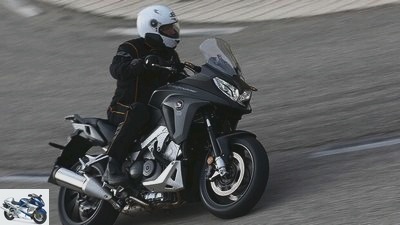
markus-jahn.com
The Honda Crossrunner proves to be a motorbike of high utility value and pleasant manners, good for work and play.
In a first impulse, the author wanted to write that the Honda Crossrunner is a motorcycle for connoisseurs. But that doesn’t quite apply. It is a motorcycle for people who do not need elemental motor power or noise to have fun driving. The running smoothness, comfort and solid workmanship appreciate, as well as all the other small and large amenities that Honda has packed into this comprehensively updated concept.
Related articles
-
Comparison test: Honda Hornet, Kawasaki Z 750, Suzuki GSR 600
Jahn motorcycles Comparison test: Honda Hornet, Kawasaki Z 750, Suzuki GSR 600 Comparison test: Honda Hornet, Kawasaki Z 750, Suzuki GSR 600 ABS shooters…
-
fact motorcycles Comparison test: Honda CBR 600 RR, Kawasaki ZX-6R, Suzuki GSX-R 600, Triumph Daytona 675, Yamaha YZF-R6 Comparison test: Honda CBR 600…
-
Jorg Kunstle motorcycles Top test Honda CBF 1000 Top test Honda CBF 1000 Fire day Amazing what can become of a super sports car. Honda combined the…
-
fact motorcycles Super athlete Top test Honda CBR 600 F Top test Honda CBR 600 F The wellness cure Sit back and close your eyes. Let yourself be kneaded…
-
Endurance test final balance: Honda Fireblade
Bilski motorcycles Endurance test final balance: Honda Fireblade Endurance test final balance of the Honda Fireblade Conclusion after 50,000 test…
-
Comparison test Honda CBF 125 against Yamaha YBR 125
fact motorcycles Comparison test Honda CBF 125 against Yamaha YBR 125 Comparison test Honda CBF 125 against Yamaha YBR 125 Inexpensive 125cc singles No…
-
Comparison test Ducati 1098S, Honda Fireblade, KTM 1190 RC8, Triumph Daytona 675, Yamaha YZF-R6
Jahn motorcycles Comparison test Ducati 1098S, Honda Fireblade, KTM 1190 RC8, Triumph Daytona 675, Yamaha YZF-R6 Comparison test Ducati 1098S, Honda…
-
Endurance test final balance Honda NC 700 S
Photo: www.r-photography.info 54 pictures www.jkuenstle.de 1/54 the Honda NC 700 S is a solid companion – not just for beginners. Gargolov 2/54 It was…
-
Honda NC 700 S in the test: the entry-level motorcycle from Honda
Artist 12th pictures Honda 1/12 Honda NC 700 S – The naked bike is powered by an in-line two-cylinder engine of 670 cubic meters. Honda 2/12 Honda NC 700…
-
Endurance test final balance Honda CBF 1000
Bilski motorcycles Endurance test final balance Honda CBF 1000 Endurance test final balance Honda CBF 1000 CBF 1000: Balance & Video Screw on, look at,…